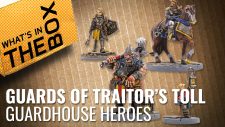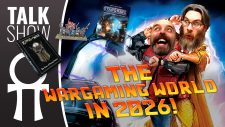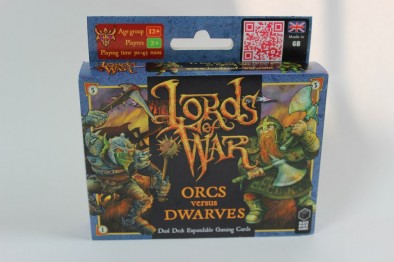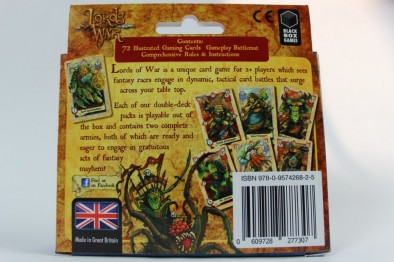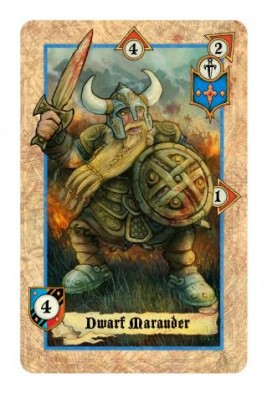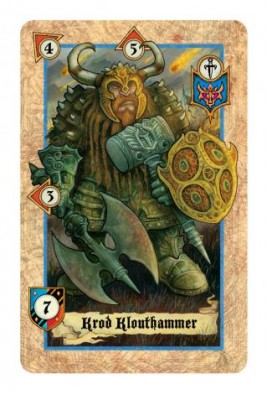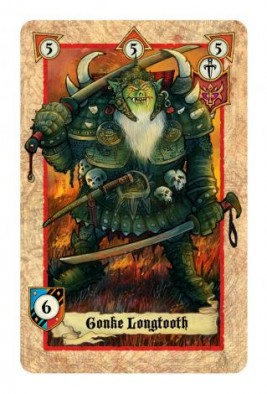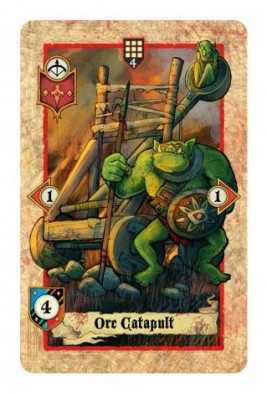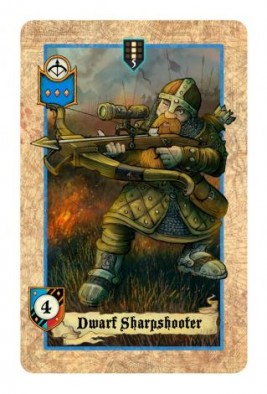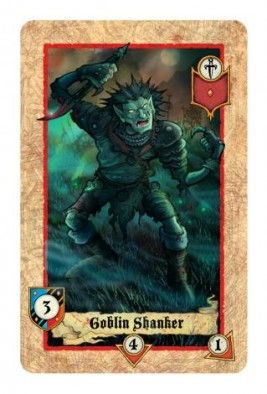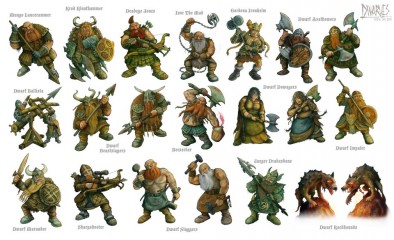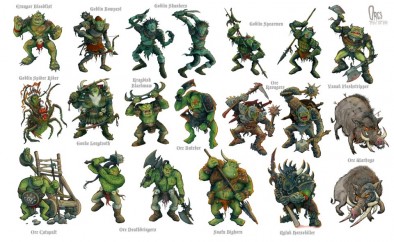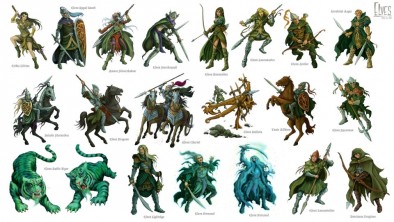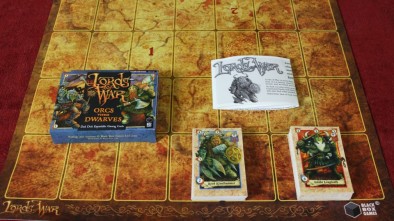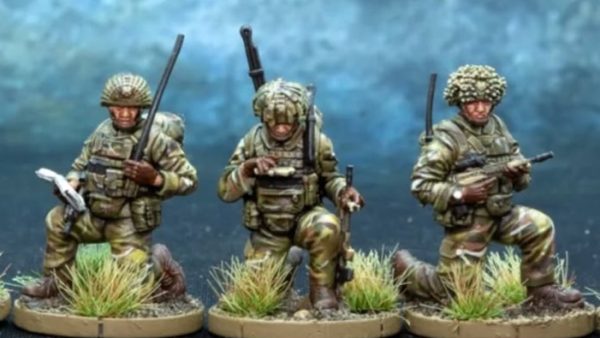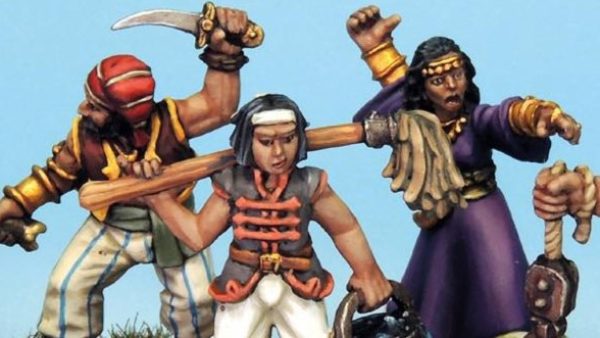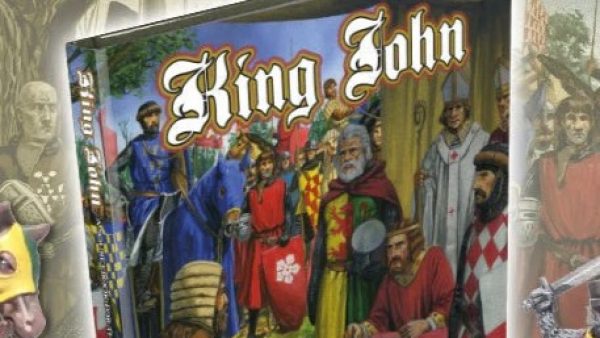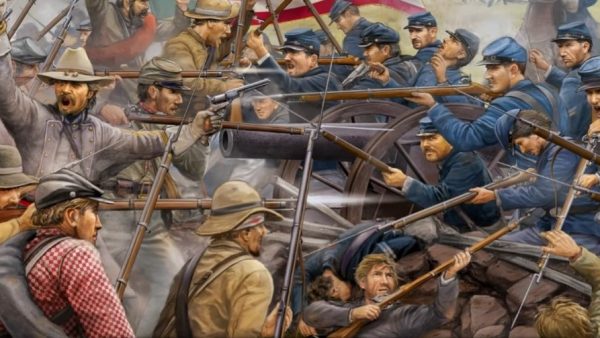Card Game Review: Lords of War – Orcs Versus Dwarves
May 29, 2013 by brennon
I popped along to the UK Games Expo on the 25th of May mainly to have a look around and had the pleasure of meeting a great company who made a great card game that was intensely fun. So, here is my review of Lords of War by Black Box Games.
Lords of War is a tactical deck based card game where mighty fantasy armies clash on the battlefield. Enigmatic and interesting leaders work together with stalwart foot soldiers on a level that has plenty of tactical depth and oodles of replay value.
Adding to this tactical play, which we'll get into later, the game has a huge chunk of lore that backs up the various factions in the game. For example the Dwarves are a mighty race that weathered the ages of Dragons and are now beating an empire out on the overworld.
The rest of the races too have plenty of depth to them, giving you a reason for the fighting. The Orcs are a mighty race of warriors who managed to stick it out through the toughest of eras and the Elves and Lizardmen that are coming soon to the game have plenty of mystery surrounding them.
While it's not an entirely original take on the fantasy genre it's a welcome addition to the game. It's always nice to know a little bit more about the heroes you're using on the battlefield and why they're getting involved in the conflict. But now let's move onto the rules...
Rules
First up we should go into detail about the cards themselves. Each card has a class, a rank and a name. The class of the card is helpful for working out it's usefulness on the battlefield. For example an infantry card is an all rounder. Cavalry units have a varied attack range, Ranged units strike from afar and Berserkers have low health but plenty of damage output.
Next up is the rank of the card and for the most part this only matters when you're looking at the upper echelons. Commanders and your General are extremely powerful cards that take the form of named heroes and should be used wisely. If you slip up with them then it could be game over before you know it.
Next you'll notice that each of the cards has a number of arrows in the corners or on the sides. These are the directions of attack and the amount of damage they do to enemies in that space. Some models, Ranged especially, have an added missile damage grid allowing them to fire projectiles at a number of different squares for spread damage.
When you start the game you take your pre-made decks and shuffle them together, taking care to remove each of your generals as he is always in your hand at the start of the game. You then deal out five cards in addition to your general taking your hand size to six. You will always have six cards in your hand.
To begin the game you will decide who is first player and who is second and place a unit in your respective sections of the gaming area. I have found that this takes away some of the ''first player always wins'' syndrome that you can find in some games. From this point on it's a tactical game of placing cards to eliminate your opponents units and preserving your own.
When you place a card you must place it adjacent to an enemy with the exception of Ranged units and Spear units who can be placed next to allied units to use their abilities. Once a card is placed you move onto the Elimination Phase where you check the damage against cards your adjacent too.
The Elimination phase is fairly simple too. If you're cards attack power on a given direction beats (and I must stress beats) your opponents defence then they have been destroyed. Similarly if your opponents attack beats your defence, you've been destroyed too. This means that when placing cards you have to consider the retaliation of the enemy. However it doesn't stop you making sacrificial pawns of your troops if it gives you an advantage further down the line, much like chess.
You can place your cards into combat and end up not doing enough damage to destroy either of you. In which case the models are locked into combat. This can be important for stopping ranged cards from shooting, or heroes being able to move about. Additionally if you lock a model in combat you might then be able to place a second card next to it, add your attack powers together and bring it down!
When two cards face off against one enemy it's a simple case of adding together both combat values against the enemies defence and seeing if you beat it. This of course can get rather crazy with three or four cards being used to bring down one enemy!
Ranged cards work slightly differently in the Elimination phase as when they are placed you use their ranged grid to work out who is hit. This could mean that putting something down like the Orc Catapult, which hits everything in a three by three grid, could potentially destroy a lot of cards.
After the Elimination phase you have Reinforcement. During this phase you either draw from your deck back up to a hand of six or pick up a card from the gaming mat. This is how cards can move around. There are however some rules for picking up cards from the gaming area. They cannot have been placed that turn, must not have taken part in a combat, and cannot be engaged by an enemy (have an attack arrow facing them). This does mean, as I mentioned before, using your weaker units to pin down mighty warriors has its advantages.
From this point on you play on until one of you has destroyed twenty units or bought down four of your commanders. At this point the army is in disarray and scatters to the four winds.
All this creates some interesting tactical decisions much like in chess. Do you sacrifice your heroes early to get some deadly attacks off but then risk losing as your opponent has three of them in his victory pile? Do you throw smaller troops into the meat grinder to lock down enemy troops then wade in with your general? It's much like working out the best way to use your Knight or Rook.
This is then where the depth of the game comes in. While the two available sides have a distinct play style right now, with Dwarves being heavy on the defence and the Orcs being brutal all out warriors, you still have to work out how best to deploy your forces to maximise enemy loses and avoid your own. Just like real battle your plans can utterly change in an instant too as your opponent might have drawn a beautiful card that puts paid to your schemes.
I've played a fair few games of this now and each one has been different. You'll find that because of the random draw of cards you will always have to come up with a new game plan and even if you have a hand of basic infantry if you play it right you'll be able to snatch victory from the jaws of defeat. Games are nearly always intensely close too with both sides using plenty of their deck.
There are a few niggles with the rules that made us stumble a few times. One of them is that the marking for Commanders in the rules is different to the one on the cards which ended up with us not realising what was quite going on thinking "maybe we just haven't drawn them?". However after closer inspection the Commanders are always the named heroes within your deck.
Also ranged units have a ranged grid with a little arrowed section on it that we thought indicated the way you're meant to fire. At first glance this made some of their ranged attacks odd as you presume they go in the direction the arrow points. However it's instead based on which side of the card the ranged grid is on. It's a small design point that confused us but it's easily rectified by a read through the rules a little closer.
The rules however are pretty solid and subscribe to the ''easy to learn'' ethos that is a welcome sight nowadays. Card anatomy is easy to break down and describe and it has a nice flow to it that is great for playing games between bigger bouts of something else. A game typically only takes about half an hour and you'll probably find yourself switching sides and trying it again. It's quite addictive!
Design
Now that we've talked about the rules and the game itself it's time to talk about the design. I can quite honestly say this is one of the best looking games you'll ever play. The artwork for each of the factions is utterly astounding with character filled and colourful portraits staring up at you at every moment. You will actually find yourself sitting and looking through the cards closely each time you draw a new one. They have a bit of the Ralph Bakshi about them!
Some of the artwork is reversed or imitated between the basic line infantry cards but you'd never notice. Each one has some subtle differences added to it meaning that until you do a double take they look individual. It's quite a nice touch and usually actually reflects the direction of attack for the various cards.
Everything about the game, despite it's colourful nature has a dark and grim feeling to it with dirt, mud, blood and grime making an appearance on practically every card you draw. The Orcs especially have fire and brimstone on almost every background echoing their nature as pillagers and burners of everything in their wake.
We even got a closer look at the Lizardmen and Elves at the UK Games Expo and you're in for a real treat when those get released too!
In terms of the actual boxing of the game it's all very simple and neat. Two sections are given over within the box for the factions, keeping them nicely separate. You then have the gaming mat neatly folded away within alongside the rules. It's a good little set that proves good things come in small packages! It's also refreshing to have a game where you don't have everything getting mixed up each time you put it away!
The Verdict
Lords of War is a game that I had little to no knowledge of before I went to the Expo and I'm glad I took the time to sit down and play a demo. I genuinely enjoy it and find the rules easy to grasp but with plenty of depth for those of you looking to take on a tactical challenge. As I have mentioned every game plays differently dependent on your draw and you'll find yourself playing and thinking a few turns ahead anticipating your enemies next move.
It's fascinating to play it and watch your opponents play style coming through too. For example my friend had a tactic of putting down heroes and then after I'd moved on or lost troops picking them back up to take them out of harms way. I countered that by putting down weaker units, forcing him to use them in combat or locking them from the reinforcement phase. The gameplay had to change immediately to suit these new situations and you find yourself having to come up with a new tactic on the fly.
The artwork is great, the rules are simple and fun, and the people behind the game were a joy to talk to and learn from. If this review hasn't convinced you then maybe the fact they won Best Card Game of the event will!
I'll be keeping a close eye on these guys and will hopefully be able to give you a review of the Lizardmen and Elves when they come out.
Check out their impressive art gallery (with a look at Lizardmen!) HERE.
Have you played Lords of War?
Supported by (Turn Off)
Supported by (Turn Off)
Supported by (Turn Off)





























